AUDI A4 AVANT 2008 Owners Manual
Manufacturer: AUDI, Model Year: 2008, Model line: A4 AVANT, Model: AUDI A4 AVANT 2008Pages: 368, PDF Size: 46.19 MB
Page 311 of 368

__________________________________________________ T_ ir_e_ s_ a_ n_d _ w_ h_ e
_ e_l_s __ fflll
• Never drive without the valve stem cap. The valves could get
damaged.
• If the sensors must be replaced, then the valve must also be
replaced at the same time.
For the sake of the environment
Dispose of old tires in accordance with the local requirements.•
Uniform tire quality grading
• Tread wear
• Traction AA A B C
• Temperature A B C
Quality grades can be found where applicable on the tire side wall
between tread shoulder and maximum section width
=> page 305,
fig. 221.
For example: Tread wear 200, Traction AA, Temperature A.
All passenger car tires must conform to Federal Safety Require
ments in addition to these grades .
Tread wear
The tread wear grade is a comparative rating based on the wear rate
of the tire when tested under controlled conditions on a specified
government test course .
For example, a tire graded 150 would wear one and one half (1 1/2)
times as well on the government course as a tire graded 100.
The relative performance of tires depends upon the actual condi
tions of their use, however , and may depart significantly from the
norm due to variations in driving habits, service practices and differ
ences in road characteristics and climate.
Traction
The traction grades, from highest to lowest, are AA, A, Band C.
Those grades represent the tire's ability to stop on wet pavement as measured under controlled conditions on specified government
test surfaces of asphalt and concrete. A tire marked C may have
poor traction performance
=> & .
Temperature
The temperature grades are A (the highest), B, and C, representing
the tire's resistance to the generation of heat and its ability to dissi
pate heat when tested under controlled conditions on a specified
indoor laboratory test wheel.
Sustained high temperature can cause the material of the tire to
degenerate and reduce tire life, and excessive temperature can lead
to sudden tire
failure =>& .
The grade C corresponds to a level of performance which all
passenger car tires must meet under the Federal Motor Vehicle
Safety Standard No. 109. Grades Band A represent higher levels of
performance on the laboratory test wheel than the minimum
required by law .
& WARNING
The traction grade assigned to this tire is based on straight-ahead
braking traction tests, and does not include acceleration,
cornering, hydroplaning or peak traction characteristics.
& WARNING
The temperature grade for this tire is established for a tire that is
properly inflated and not overloaded. Excessive speed, underinfla
tion, or excessive loading, either separately or in combination, can
cause heat buildup and possible tire failure.
•
Vehicle care
Page 312 of 368
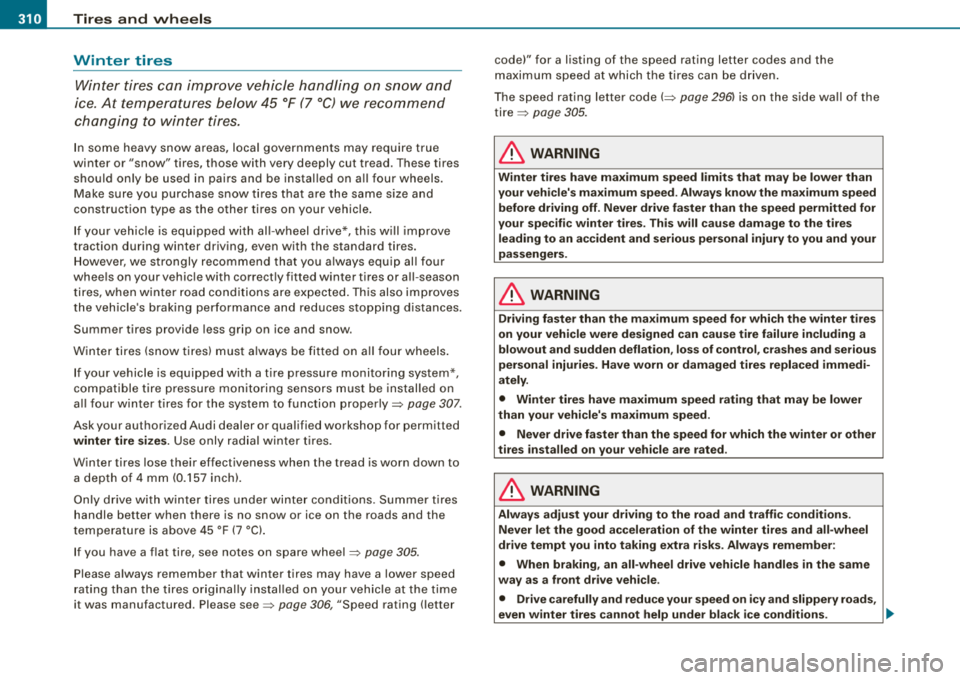
___ T_ ir_e_ s_ a_ n
_ d_ w_ h_ e_ e_l_
s _________________________________________________ _
Winter tires
Winter tires can impr ove vehicle handling on snow and
ice. At temperatures below 45 °F (7 °C) we recommend
changing to winter tires.
I n some heavy snow areas, local governments may require true
winter or "snow" tires, those with very deeply cut tread . These tires
should only be used in pairs and be instal led on a ll four wheels .
Make sure you purchase snow tires that are the same s ize and
construction type as the other tires on your vehicle .
If your vehic le is equipped with al l-wheel drive*, this will improve
traction during winter driving, even with the standard tires.
H owever, we strongly recommend that you a lways equ ip al l four
whee ls on your vehic le with correct ly fitted winter tires or all-season
t ires, when winter road conditions are expec ted. This also improves
t he vehic le's braking performance and reduces stopping distances.
Summer tires provide less grip on ice and snow.
W inter tires (snow t ires) must a lways be fi tted on a ll four wheels .
If your vehicle is equipped with a tire pressure monitoring system* ,
compatible tire pressu re monitoring sensors must be instal led on
a ll f our winter t ires for the system to function
properly=> page 307.
Ask your authorized Audi dealer or qualified workshop for permitted
winter tire size s. Use only rad ial winter tires.
Winter tires lose their effect iveness when the tread is worn down to
a depth of 4 mm (0.157 inch).
Only drive with w inter tires under winter conditions. Summer tires
handle better when there is no snow or ice on the roads and the
t emperature is above 45 °F (7 °C).
If you have a flat tire, see notes on spare
wheel=> page 305 .
Please a lways remember that winter tires may have a lower speed
rating than the tires original ly instal led on your vehicle at the ti me
it was manufactured . Please see
=> page 306 , "Speed rating (letter code)" for a listing of the speed rating letter codes and the
maximum speed at which t he tires can be d riven .
The speed rating letter
code(=> page 2961 i s on the side wa ll of the
tire => page 305.
& WARNING
Winter tire s have maximum speed limits that may be lower than
your vehi cle's ma ximum speed . Al wa ys know the ma ximum speed
before driving off . Never drive fa ster th an the speed permitted for
y our s pecifi c w inter tire s. Thi s will cau se damage to the tire s
lead ing to an a ccident and seriou s per sonal injury to you and your
p ass engers.
& WARNING
Driving fa ster th an the m aximum speed for whi ch the winte r tire s
on your vehi cle were de signed c an cause tir e failure in cluding a
blowout and sudden deflat ion , lo ss of contr ol, c rashe s and seriou s
per sonal injuries . Have worn or damaged tires repl aced immedi
ately .
• Winter tires have ma ximum speed rating that may be lower
than your vehicle' s m axi mum speed .
• Never drive faster than the speed for which the winter or other
ti re s in sta lled on you r vehi cle are r ated .
& WARNING
Always adju st your driving to the ro ad and traff ic condit ions .
Never let the good acceleration of th e win ter tire s and all-wheel
dr ive tempt you into taking extra ri sks. Al ways rem ember :
• When braking, an all -wheel driv e vehicle handle s in th e same
w ay as a front dr ive veh icle .
• Drive ca refully and redu ce your speed on i cy and slippery r oads,
e ven w inter tires cannot h elp under bl ack ice condit ions .
...,
Page 313 of 368
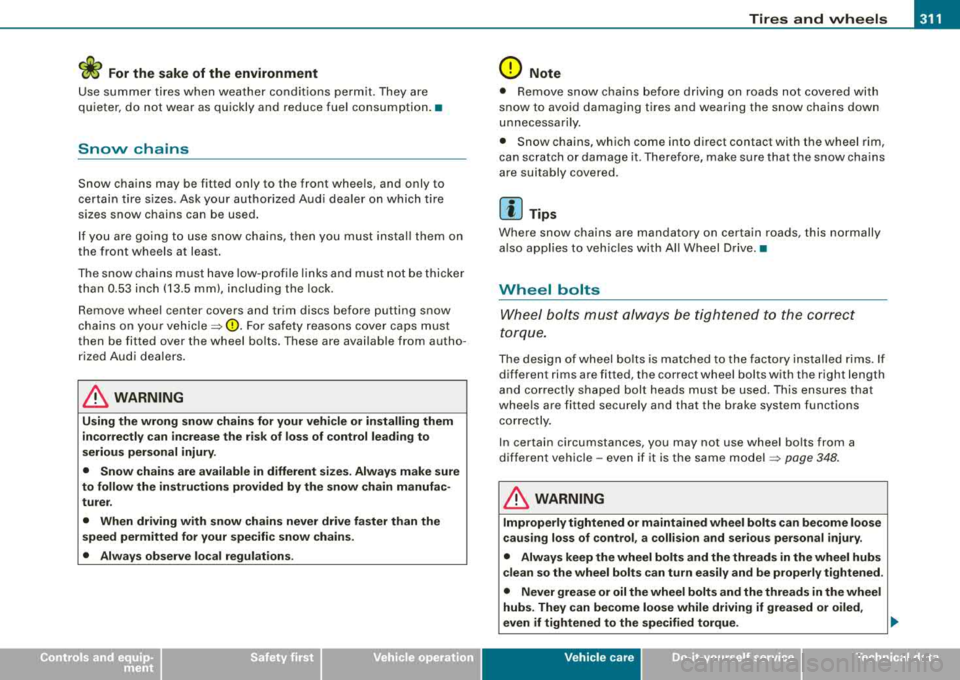
Tires and wheels 1111
----------------
W For the sake of the environment
Use summer tires when weather conditions permit. They are
quieter, do not wear as quickly and reduce fuel consumption. •
Snow chains
Snow chains may be fitted only to the front wheels, and only to
certain tire sizes. Ask your authorized Audi dealer on which tire
sizes snow chains can be used.
If you are going to use snow chains, then you must install them on
the front wheels at least.
The snow chains must have low-profile links and must not be thicker
than 0.53 inch (13.5 mm), including the lock.
Remove wheel center covers and trim discs before putting snow
chains on your
vehicle => 0. For safety reasons cover caps must
then be fitted over the wheel bolts. These are available from autho
rized Audi dealers.
& WARNING
Using the wrong snow chains for your vehicle or installing them
incorrectly can increase the risk of loss of control leading to
serious personal injury.
• Snow chains are available in different sizes. Always make sure
to follow the instructions provided by the snow chain manufac
turer.
• When driving with snow chains never drive faster than the
speed permitted for your specific snow chains.
• Always observe local regulations .
0 Note
• Remove snow chains before driving on roads not covered with
snow to avoid damaging tires and wearing the snow chains down
u n necessarily.
• Snow chains, which come into direct contact with the wheel rim,
can scratch or damage it . Therefore, make sure that the snow chains
are suitably covered.
[ i] Tips
Where snow chains are mandatory on certain roads, this normally
also applies to vehicles with All Wheel Drive. •
Wheel bolts
Wheel bolts must always be tightened to the correct
torque.
The design of wheel bolts is matched to the factory installed rims. If
different rims are fitted, the correct wheel bolts with the right length
and correctly shaped bolt heads must be used. This ensures that
wheels are fitted securely and that the brake system functions
correctly.
In certain circumstances, you may not use wheel bolts from a
different vehicle -even if it is the same
model => page 348.
& WARNING
Improperly tightened or maintained wheel bolts can become loose
causing loss of control, a collision and serious personal injury.
• Always keep the wheel bolts and the threads in the wheel hubs
clean so the wheel bolts can turn easily and be properly tightened .
• Never grease or oil the wheel bolts and the threads in the wheel
hubs. They can become loose while driving if greased or oiled,
even if tightened to the specified torque.
.,_
Vehicle care
Page 314 of 368
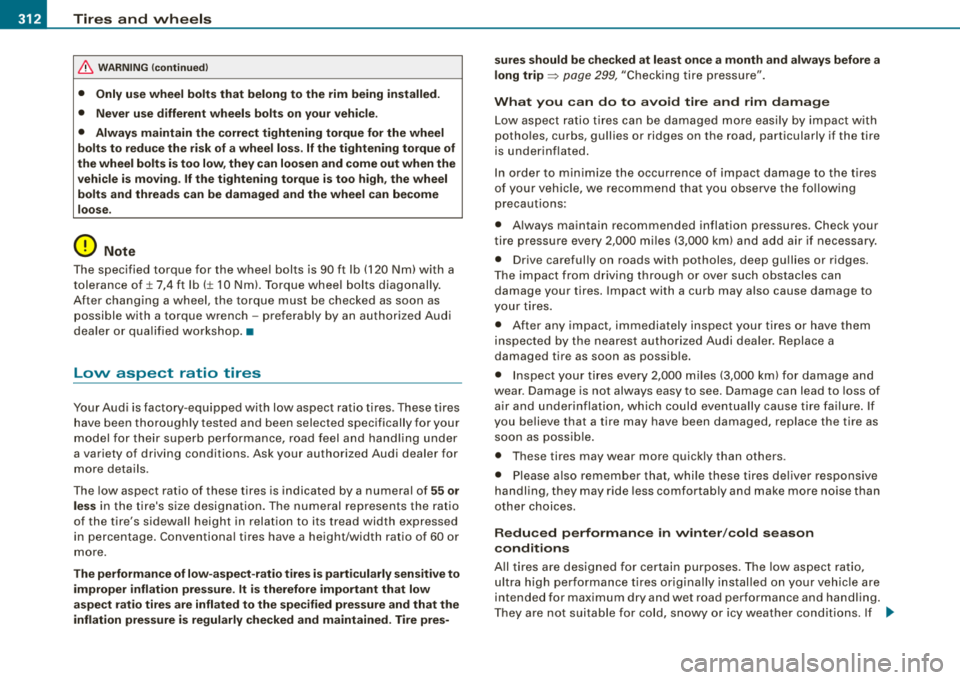
-
Tires and wheels
----------------
&, WARNING (continued )
• Only u se wheel bolts that belong to the rim being installed.
• Never use different wheels bolt s on your vehi cle .
• Alway s maintain the correct tightening torque for the wheel
bolts to reduce the risk of a wheel los s.
If the tightening torque of
the wheel bolts is too low , they can loosen and come out when the
vehi cle is moving. If the tightening torque is too high , the wheel
bolts and threads can be damaged and the wheel can become
loose .
0 Note
The specified torque for the wheel bolts is 90 ft lb (12 0 Nm) with a
tolerance of± 7,4 ft lb(± 10 Nm). Torque whee l bolts diagonally.
After changing a wheel, the torque must be c hecked as soon as
possible with a torque wrench -preferably by an authorized Audi
d ea ler or qua lifi ed works hop.•
Low aspect ratio tires
Your Aud i is factory -equipped with low aspect ratio tires . T hese tires
have been thorough ly tested and been selected specifical ly for your
mod el for t he ir superb perf or mance, r oad feel and ha ndling u nder
a variety of driving conditions . Ask your authorized Audi dealer for
mo re deta ils.
The low aspect ratio of these tires is indicated by a numeral of
55 or
less
i n the ti re's size designatio n. The numeral rep resents the ra tio
of the t ire's sidewa ll height in relation to its tread width expressed
in percentage . Conventiona l tires have a height/width ratio of 60 or
m ore.
The performan ce of low -aspe ct-ratio tires is part icularly sensitive to
improper inflation pressure . It is therefore important that low
aspe ct ratio tires are inflated to the specified pressure and that the
inflation pressure i s regularly checked and maintained. Tire pres- sures should be checked at least once a month and always before a
long
trip => page 299, "C heck ing tire pre ssure" .
What you can do to avoid tire and rim damage
Low as pect r ati o ti res can be da maged more easi ly by impact w ith
potho les, curbs, gullies or ridges on the road, particularly if the tire
i s u nde rinfl ated.
I n order to min imize the occurrence of impact damage to the t ires
of your vehic le, we recommend that you observe the fo llowing
precautions :
• Always maintain recommended inflation pressures . Check your
t ire pr essu re every 2,000 miles (3,000 k m) a nd add air if necessary .
• Drive careful ly on roads with potholes, deep gu llies or ridges.
T he im pac t from driving t hroug h or ov er suc h ob stacl es ca n
damage your tires. Impact with a curb may also cause damage to
yo ur tir es .
• After any impact, immediately inspect your tires or have them
inspec te d by the neares t au thori ze d Aud i dealer. Replac e a
damaged tire as soon as possible.
• I nspect you r ti res eve ry 2,0 00 m iles (3,000 km) for damage and
wear. Damage is not always easy to see. Damage can lead to loss of
a ir a nd und eri nfl ation, whic h cou ld eve ntual ly ca use tire fa ilur e. If
you be lieve that a tire may have been damaged, rep lace the tire as
s o on as p ossi ble.
• T hese tires may wear more quickly than others .
• P lease a lso remember that, whi le these tires de liver respons iv e
handling, they may ride less comfortably and make more noise t han
other choices.
Reduced performance in winter /cold season
c onditions
A ll tir es a re desig ned f or certai n purposes. The low a spect rati o,
u ltra hi gh pe rf ormance t ires or igin a lly ins tal led on your ve hicle are
intended for maximum dry and wet road performance and handling .
Th ey a re not su itab le fo r co ld, snowy or ic y weat her co nd it io ns. If
~
Page 315 of 368
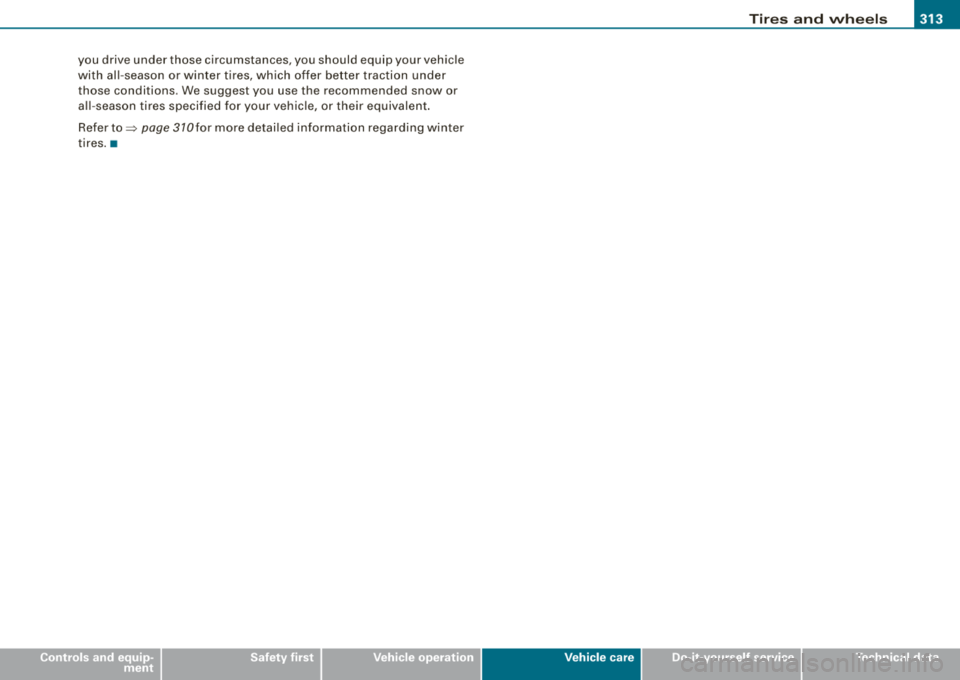
Tires and wh eels -
----------------
you drive under those circumstances, you should equip your vehicle
with al l- season or win ter t ires, wh ich offer be tter traction under
those conditions . We suggest you use the recommended snow or
a ll-season tires specified for your vehicle, or their equivalent .
Refer
to => page 310for more detai led information regarding winter
tires. •
Vehicle care
Page 316 of 368
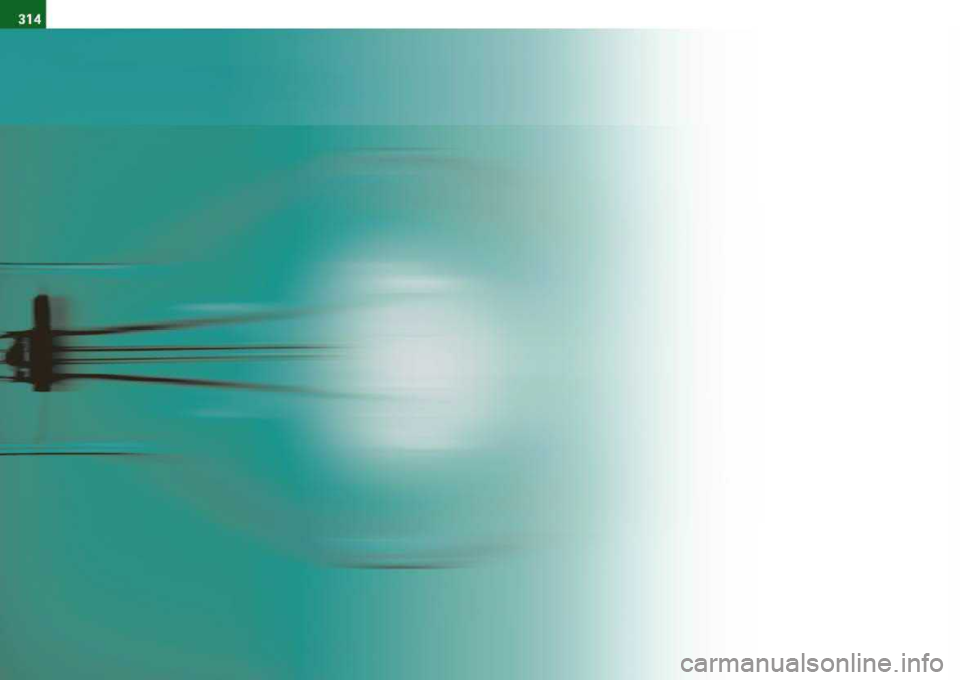
Page 317 of 368
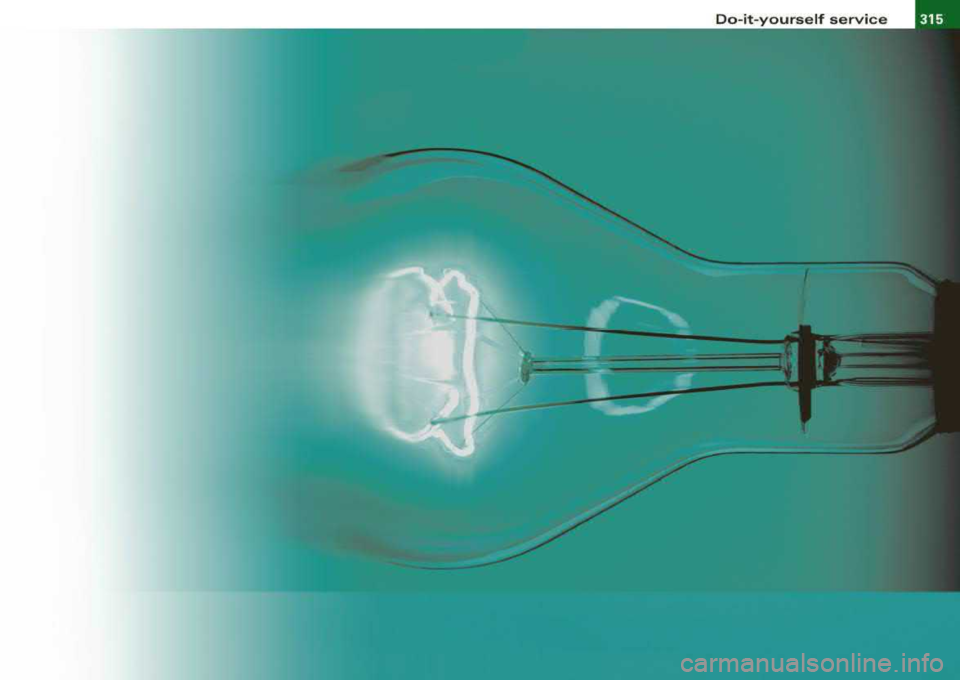
Page 318 of 368
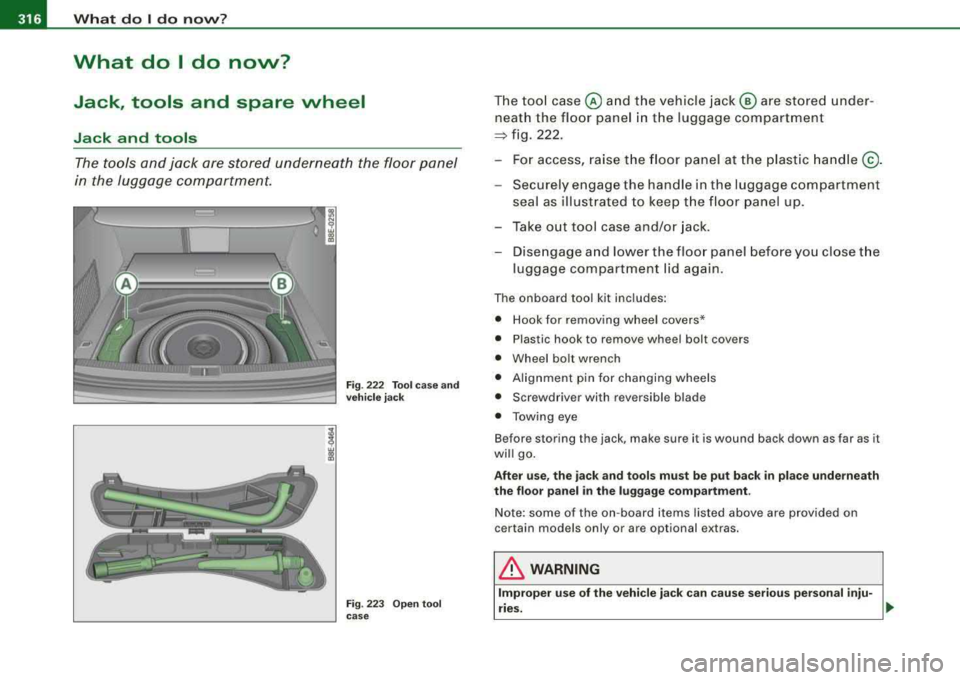
lllffll....__W_ h_ a_ t_d_ o_ l _d _o_ n_ o_ vv_ ? ______________________________________________ _
What do I do now?
Jack, tools and spare wheel
Jack and tools
The tools and jack are stored underneath the floor panel
in the luggage compartment.
F ig. 222 Tool case and
ve hicle jack
Fi g. 223 O pen too l
case
The tool case @ and the vehicle jack@ are stored under
neath the floor panel in the luggage compartment
=> fig. 222.
- For access, raise t he floor panel at the plastic ha ndle @ .
- Securely engage the handle in the luggage compartment
seal as illustrated to keep the floor panel up.
- Take out tool case and/or jack.
- Disengage and lower the floor panel before you close the
luggage compartment lid again.
The onboard tool kit inc ludes:
• Hook for removing wheel covers*
• Plastic hook to remove wheel bolt covers
• Wheel bo lt wrench
• Alignment pin for changing wheels
• Screwdriver with reversible blade
• Towing eye
Before storing the jack, make sure it is wound back down as far as it
will go.
Afte r use, th e ja c k a nd tools m us t b e put bac k in pl ace u nderneath
th e floor p an el in th e lu g gage c omp artment .
Note: some of the on -board items listed above are provided on
certain models only or are optional extras.
& WARNING
Improper us e of th e vehi cle ja ck ca n ca use se rious pe rso nal inju
r ies.
Page 319 of 368
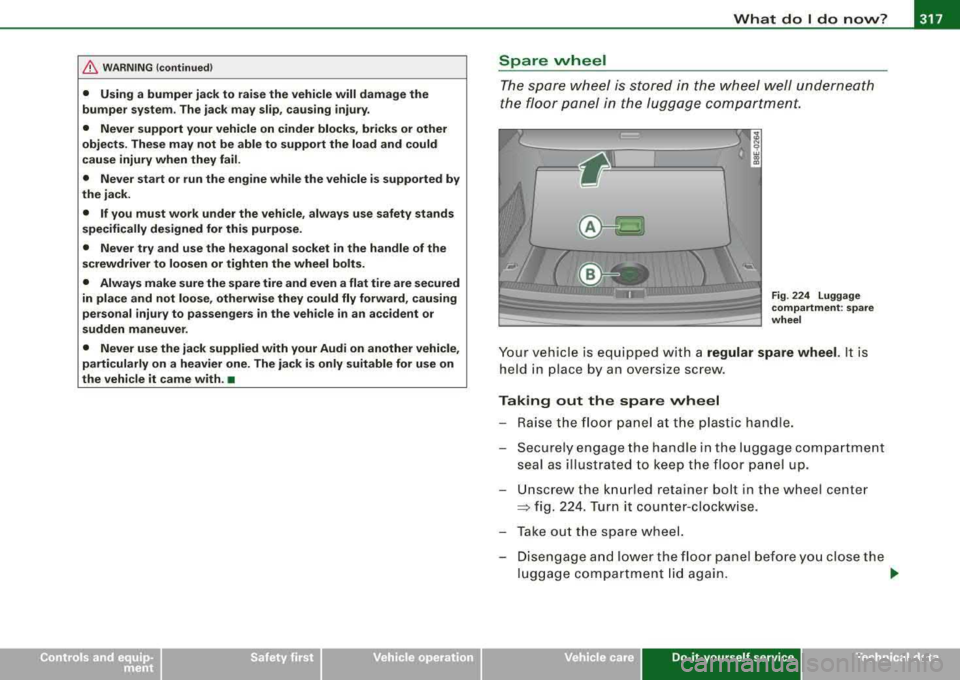
_____________________________________________ W_ h_ a_t _d_ o_l
_ d_o _ n_o_ w_ ? _ __,_
/b, WARNING (continued)
• Using a bumper jack to raise the vehicle will damage the
bumper system. The jack may slip, causing injury.
• Never support your vehicle on cinder blocks, bricks or other
objects. These may not be able to support the load and could
cause injury when they fail.
• Never start or run the engine while the vehicle is supported by
the jack.
• If you must work under the vehicle, always use safety stands
specifically designed for this purpose.
• Never try and use the hexagonal socket
in the handle of the
screwdriver to loosen or tighten the wheel bolts.
• Always make sure the spare tire and even a flat tire are secured
in place and not loose, otherwise they could fly forward, causing
personal injury to passengers in the vehicle in an accident or
sudden maneuver.
• Never use the jack supplied with your Audi on another vehicle,
particularly on a heavier one. The jack is only suitable for use on
the vehicle it came with.
•
Spare wheel
The spare wheel is stored in the wheel well underneath
the floor panel in the luggage compartment.
Fig. 224 Luggage
compartment : spare
wheel
Your vehicle is equipped with a regular spare wheel. It is
held in place by an oversize screw.
Taking out the spare wheel
- Raise the floor panel at the plastic handle.
- Securely engage the handle in the luggage compartment
seal as illustrated to keep the floor panel up.
- Unscrew the knurled retainer bolt in the wheel center
=> fig. 224. Turn it counter -clockwise .
- Take out the spare wheel.
- Disengage and lower the floor panel before you close the
luggage compartment lid again.
..,.
Do-it-yourse lf service irechnical data
Page 320 of 368

___ w_ h_ a_t _ d_ o_ l_d _ o_ n_ o_w _ ? ______________________________________________ _
Storing the replaced wheel
- Place the replaced wheel inside the spare wheel well in
the luggage compartment.
- Tighten the knurled retaining screw clockwise to secure
the wheel in place.
- Disengage and lower the floor panel before you close the
luggage compartment lid again.
& WARNING
Loose items in the passenger compartment can cause serious
personal injury during hard braking or in an accident.
• Never store the spare wheel or jack and tools
in the passenger
compartment.
• Always store all jacking equipment, tools, and the spare wheel
in the luggage compartment.
• Tighten the knurled retaining screw for the spare wheel
securely.
[ i] Tips
Check the inflation pressure of the spare tire periodically to keep the
tire ready for use. •
Wheel change
Before changing a wheel
Follow these points for your own and your passenger's
safety when replacing a wheel.
After you experience a tire failure, pull the car well away
from moving traffic and try to reach
level ground before
you
stop ~& .
-All passengers should leave the car and move to a safe
location (for instance, behind the
guardrail) ~& .
-Apply the parking brake firmly ~& .
-Move selector lever to position P on an automatic trans-
mission; put manual transmission in
first gear~& .
-If you are towing a trailer: unhitch the trailer from your
vehicle.
- Take the
tool case and the spare tire ~ page 316 out of
the luggage compartment.
& WARNING
You or your passengers could be injured while changing a wheel if
you do not follow these safety precautions:
• If you have a flat tire, move a safe distance off the road. Turn off
the engine, turn the emergency flasher on and use other warning
devices to alert other motorists.
• Make sure that passengers wait
in a safe place away from the
vehicle and well away from the roadway and traffic.
• To help prevent the vehicle from moving suddenly and possibly
slipping off the jack, always fully set the parking brake and block
the wheel diagonally opposite the wheel being changed . When one
front wheel is lifted off the ground, placing the Automatic Trans-
~